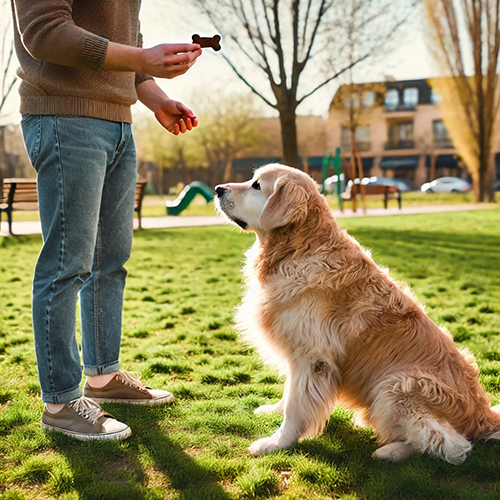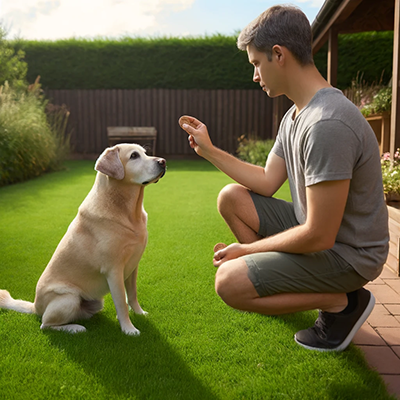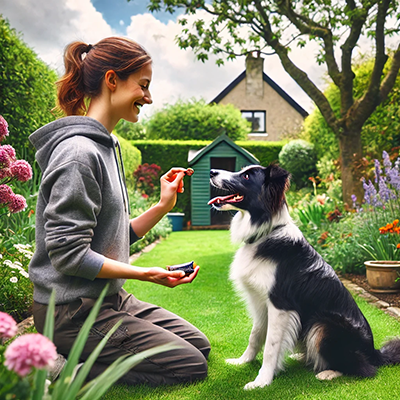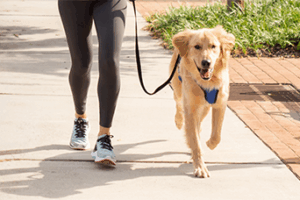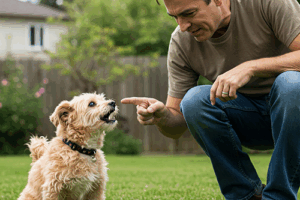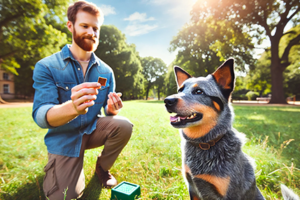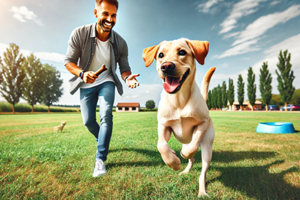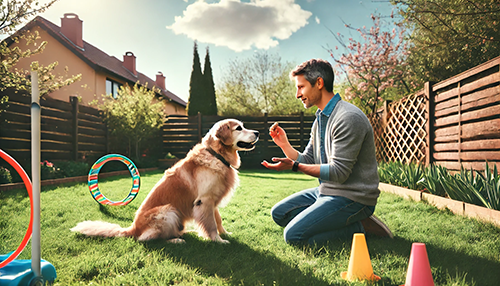
Those who have adopted older pets can relate to the challenges of training older dogs instead of a puppy. Even so, training a senior canine family member is possible, and the rewards are well worth the effort.
Can You Train an Older Dog
Training older dogs can be a rewarding experience, but it’s essential to do it correctly. The first step is to teach your basic pup commands like sit, stay, and come. Break down tasks into smaller steps and reward your pup with treats, praise, or playtime when they do something right. Be mindful of the physical limitations of older dogs and adjust the amount of exercise and training accordingly.
Positive reinforcement is vital when training older dogs. Treats, praise, and playtime should reward desired behaviors and avoid punishing bad behavior. Establish a routine and stick with it so your canine companion knows what to expect. Spend valuable time with your dog and provide plenty of mental and physical stimulation. Keep training sessions short and fun so your dog stays engaged and interested.
With patience, consistency, and positive reinforcement, an older pup can learn new tricks. Training older dogs can be an advantageous experience and a great way to bond with your senior canine family member. With the right approach, you can help your dog learn new behaviors and develop better habits.
Benefits of Training, an Older Dog
Older dogs may better understand what is expected of them, making them easier to train. This can help reduce unwanted behaviors in the dog and create a stronger bond between the dog and the owner. Training can also provide mental stimulation, helping to keep an older dog sharp and engaged.
In addition to providing mental stimulation, training can help increase an older dog’s confidence and independence. This can make interacting with the dog more enjoyable for the dog and the owner. Training can also help to create a healthier lifestyle for older dogs, as it helps to keep them physically and mentally fit.
Training older dogs can be a great way to bond with them and keep them healthy. It can help to reduce unwanted behaviors, increase their confidence, and provide mental stimulation.
The Importance of Training Your Senior Dog
Senior dogs are just as capable of learning new behaviors and commands as younger dogs; teaching them is vital for their mental and physical health. Training older dogs can help keep them mentally active and alert and prevent boredom and depression. It can also help them cope with changes in their environment and routine and deal with new people and animals.
Training can help senior dogs stay physically healthy by assisting them in remaining active and engaged. It can also help prevent them from developing common physical issues. Training can help build a strong bond between you and your older dog and reinforce the trust between you. It can also help reduce behavioral problems, such as barking and destructive behaviors, that can often arise in senior dogs.
How to Train an Older Dog to Pee Outside
You can help your pet learn proper potty etiquette with patience, consistency, and positive reinforcement. First and foremost, ensure your dog is healthy and free from any medical conditions that might interfere with potty training. If your dog has problems, it’s best to take it to the vet to ensure it is in order.
Once your canine companion is healthy, the next step is establishing a regular potty schedule and sticking to it. Take your dog to the same spot in your yard each time to go potty and incentivize them with treats and positive reinforcement when they go in the right place. This will help them remember where they should be doing their business.
It’s also important to stay consistent with potty training and be patient with your older dog. Clean the area thoroughly if your dog has accidents inside to remove any lingering scent. If your dog has difficulty remembering to go outside, try reminding them using a bell or whistle.
Please pay attention to your dog’s body language and take them out when necessary. You can help your older dog learn proper potty etiquette with patience and consistency. Your new senior addition to the family can learn to be a perfect house guest with the appropriate training.
How to Train an Older Dog with Bad Habits
The secret is to start with the basics and build up from there. Teach your dog fundamental obedience commands like sit, stay, come, and down.
Use positive reinforcement – reward your dog with treats, praise, or playtime when they do something correctly. Be consistent with commands, rewards, and punishments. Remember that older dogs may take longer to learn new behaviors, so be patient and don’t give up.
If your dog has terrible behaviors, work on correcting them by replacing them with good behaviors. Ensure your dog is getting enough exercise to expend energy and stay mentally stimulated. Socializing is also essential – introduce your dog to other people and animals to help them behave better and be less fearful.
Remember that setting boundaries is essential when training older dogs. Establish a routine and clear boundaries for your dog so they know what behaviors are acceptable. If the problem persists, consider seeking help from a professional dog trainer.
How to Train an Older Dog to Stop Barking
Please seek the advice of a dog trainer or behaviorist who can help you find the root cause of the dilemma and create a plan to address it. To ensure the best results, it’s essential to understand why the dog may be barking in the first place. Common causes range from boredom and confusion to anxiety, and it’s crucial to identify and remove any triggers that could be causing the barking.
When the dog starts barking, it’s important not to respond. Instead, ignore the barking and reward the dog with a treat or toy when it stops. It’s also vital to ensure the dog gets enough exercise and mental stimulation to help prevent boredom or anxiety that could lead to barking. If the problem persists, it’s best to consult a professional dog trainer or behaviorist. They can help identify the root cause of the barking and create a plan to address it.
How to Train an Older Dog Not to Be Aggressive
Is the aggression due to fear, anxiety, or territorialism? Identifying the source of the aggression will help you tailor your training methods to your dog’s specific needs. Providing structure and consistency to the dog’s day-to-day life can help it better understand its expectations and reduce stress levels.
Positive reinforcement is vital to successfully training an older dog. Rewarding them with treats and praise when they display good behavior will help reinforce and promote the desired behavior in the future. Regular walks, running, and playtime are essential for an older dog’s physical and mental health.
When training older dogs, consistency with discipline is essential. Reprimand the dog if it acts out, but don’t be too harsh. Finally, make sure to give the dog plenty of mental stimulation. Engaging the dog in activities like puzzle toys and obedience games can help keep it mentally stimulated and prevent boredom.
How to Train an Older Dog to Sit
The first step is to get your older dog used to basic commands, starting with “sit” and “stay.” Positive reinforcement, such as treats and verbal praise, is essential when teaching these commands. If your older dog has trouble understanding the command, try using a hand signal. If your dog has trouble getting into the sitting position, use a treat to encourage him to sit.
Give your older dog plenty of breaks during training and reward him for his progress. Once your older dog can stay sitting for a few seconds, gradually increase the time. You can teach your older dog the basic commands with patience and consistent training.
What are the Challenges of Training an Older Dog
Establishing the basics is the first step in training an older dog. This may include teaching them simple commands they may not have been exposed to. Training older dogs requires patience and consistency, as learning new behaviors and commands may take longer. Physical limitations can also affect an older dog’s ability to learn. This may include arthritis, vision problems, or other age-related issues. It is essential to consider these physical limitations when training older dogs.
Adjusting to change is also essential when training older dogs. Any new training or changes should be introduced slowly to ensure your dog can adapt. It is also necessary to manage any existing behaviors. This may involve being patient and consistent to follow the desired behavior.
Are There Special Concerns I Should Take into Account When Training Older Dogs
As your dog becomes more comfortable, you can increase the difficulty level. However, it’s important not to overwork your senior canine family member. Take frequent breaks and provide plenty of mental and physical stimulation to keep your dog involved and interested in learning.
Positive reinforcement is critical when training older dogs. Rewarding good behavior with treats or praise will help them understand what is expected of them. However, it’s also important not to expect too much too quickly. Training older dogs takes time and patience, so don’t be discouraged if you don’t see immediate results. Your dog will be trained in no time with consistent guidance and plenty of love.
DISCLAIMER: The information on shihtzudoginformation.com is intended for general knowledge and informational purposes only. The content is not a substitute for professional veterinary advice, diagnosis, or treatment. Always seek the advice of your veterinarian or other qualified animal health provider with any questions you may have regarding your dog’s health or medical condition.
References
- American Kennel Club’s research on older dog training
- Article on the Clever Dog Lab’s research on aging and cognition: https://www.sciencedaily.com/releases/2016/02/160202121818.htm

